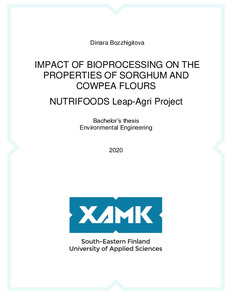IMPACT OF BIOPROCESSING ON THE PROPERTIES OF SORGHUM AND COWPEA FLOURS
Bozzhigitova, Dinara (2020)
Julkaisun pysyvä osoite on
https://urn.fi/URN:NBN:fi:amk-202201021014
https://urn.fi/URN:NBN:fi:amk-202201021014
Tiivistelmä
The aim of this study was to assess the impact of enzymatic treatment and fermentation on the functional properties of Sorghum and Cowpea flours intended to be used in baking applications. Both crops are known as African Climate-Smart Food Crops which are not utilised to their fullest potential due to inaccessibility of the part of the nutrients and unsatisfactory sensory evaluation. Thesis is a part of NUTRIFOODS Project the aim of which is to increase demand in local sustainable crops. The aim of sorghum treatment was to solubilise insoluble dietary fibre, which contributes to the poor taste of sorghum-based products, and to hydrolyse insoluble proteins, which limit the nutritional value of the flour. The aim of cowpea treatment was to increase the protein solubility.
For sorghum, cell wall degrading enzymes were used to solubilise dietary fibre. The results were promising, Viscozyme L (1%, 4h, 50 °C) solubilised 23% more dietary fibre compared to the control sample. The effectiveness of enzymes was increased with longer incubation time. Proteases had minor effect on the protein hydrolysis, the highest increase was from 6.3% (control, 4h, 50 °C) to 9.3% (FlavourSEB, 0.5%, 4h, 50 °C). At pH 4 and 5 protein solubility decreased. Combination of proteases, cell wall degrading enzymes, phytase and amylase did not have a significant difference in protein solubility. The proteases treatment of cowpea increased protein solubility from 29% (control) to 48%, (FlavourSEB, 0.5%, 4h, 50 °C). The combination of protease with cell wall degrading enzyme, phytase, amylase did not improve protein solubility compared to FlavourSEB alone. However, combination protease+phytase (FlavourSEB 0.5%+1% UltraBio, 4h, 50 °C) increased protein hydrolysis to 55.4% when measured at pH4. Protein solubility of control and sample treated only with protease was lower at pH 4 and 5 than at native pH (~ 6.2). Fermentation of both flours with lactic acid bacteria did not have a significant effect on protein solubility.
Selected enzymes will be used with fermentation trials and further tested in bread baking. Thesis results can assist in decision making in future development of sorghum and cowpea functional and nutritional characteristics. Improvement of nutritional and functional characteristics of sorghum and cowpea flours can increase the acceptability of bakery goods, thereby decreasing demand in wheat flour.
For sorghum, cell wall degrading enzymes were used to solubilise dietary fibre. The results were promising, Viscozyme L (1%, 4h, 50 °C) solubilised 23% more dietary fibre compared to the control sample. The effectiveness of enzymes was increased with longer incubation time. Proteases had minor effect on the protein hydrolysis, the highest increase was from 6.3% (control, 4h, 50 °C) to 9.3% (FlavourSEB, 0.5%, 4h, 50 °C). At pH 4 and 5 protein solubility decreased. Combination of proteases, cell wall degrading enzymes, phytase and amylase did not have a significant difference in protein solubility. The proteases treatment of cowpea increased protein solubility from 29% (control) to 48%, (FlavourSEB, 0.5%, 4h, 50 °C). The combination of protease with cell wall degrading enzyme, phytase, amylase did not improve protein solubility compared to FlavourSEB alone. However, combination protease+phytase (FlavourSEB 0.5%+1% UltraBio, 4h, 50 °C) increased protein hydrolysis to 55.4% when measured at pH4. Protein solubility of control and sample treated only with protease was lower at pH 4 and 5 than at native pH (~ 6.2). Fermentation of both flours with lactic acid bacteria did not have a significant effect on protein solubility.
Selected enzymes will be used with fermentation trials and further tested in bread baking. Thesis results can assist in decision making in future development of sorghum and cowpea functional and nutritional characteristics. Improvement of nutritional and functional characteristics of sorghum and cowpea flours can increase the acceptability of bakery goods, thereby decreasing demand in wheat flour.
